Saturday, October 16, 2004
Billon antoninianus, Saloninus, Samosata, Göbl 1696d
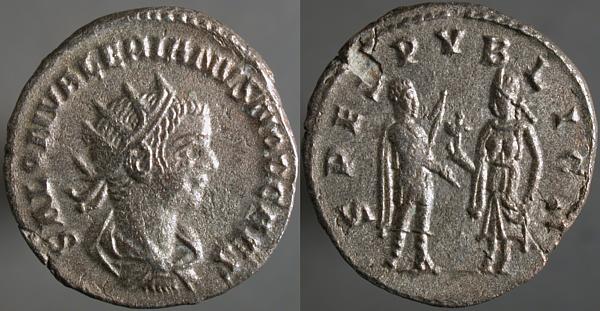
SALON VALERIANVS NOB CAES, Radiate draped bust right | SPES PVBLICA, Spes standing left, presenting flower to Saloninus.
Spes was the Roman goddess of hope, and is often seen on coins of newly-raised Caesars. In this family, almost everybody got a Spes. They all came to bad ends, anyway. Memento mori, and all that.
Friday, October 15, 2004
Æ25, Nicaea in Bithynia, Gallienus, Lindgren I, 156 (this coin)
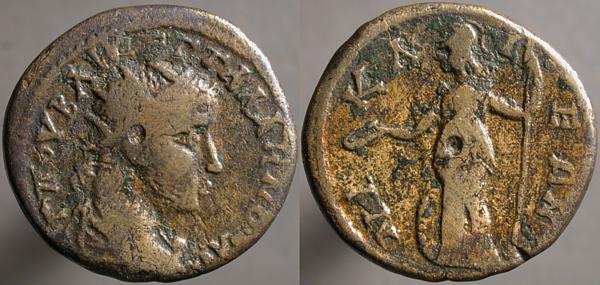
ΠΟVΒ ΛΙΚ ΕΓ ΓΑΛΛΙΗΝΟ[C] ΑV, Radiate draped cuirassed bust right | ΝΙ_ΚΑ_Ι_ΕΩΝ, Athena standing facing, head left, holding spear right and patera left. Shield at feet left.
The full name of Gallienus was Publius Licinius Egnatius Gallienus, but Egnatius isn't included in the legends of imperial coins. I do have examples of provincial coins from Bithynian cities abbreviating it ΕΓ and from Side in Pamphylia using ΕΓΝ.
It seems clear that provincial mints had quite a bit of leeway in the names as well as the portraits.
Thursday, October 14, 2004
Æ sestertius, Valerian, Rome, Göbl 76h
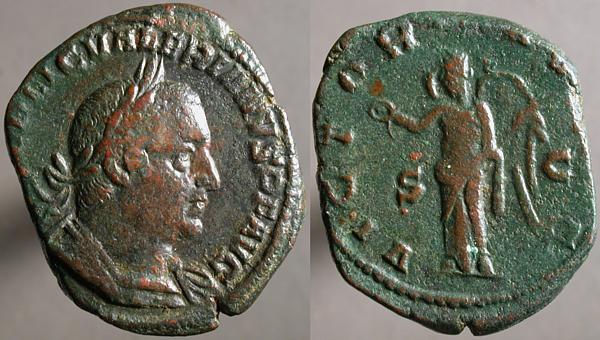
IMP C P LIC VALERIANVS P F AVG, Laureate cuirassed bust right | VICTORIA AVGG, Victory standing facing, head left, presenting wreath left and holding transverse palm. S_C across fields.
Some of the most appealing Roman coins are the big brass sestertii of the first and second centuries. The large size provided the mint with the opportunity to execute complex designs.
By the middle of the third century, while still the physically largest imperial coin, the sestertius had been reduced to a smaller bronze coin which usually had the same designs as other contemporary issues, and apparently the desire to produce a round shape was lacking. At or near the end of Gallienus's reign the anonymous GENIVS P R series of sestertii and double sestertii demonstrated the the ability to do so was not lost.
Wednesday, October 13, 2004
AR denarius, Rome, Hadrian, RIC 216a
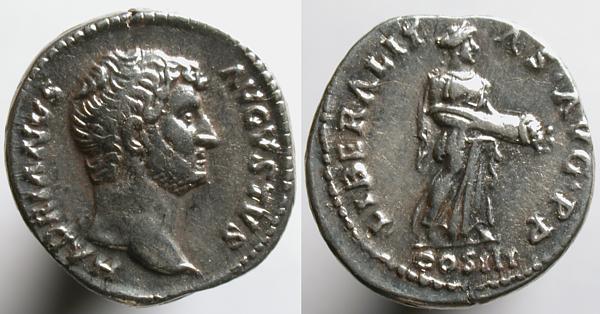
HADRIANVS AVGVSTVS, Bare head right | LIBERALITAS AVG P P COS III, Liberalitas standing right, emptying a cornucopia.
Publius Aelius Traianus Hadrianus was raised to emperor on Trajan's death in 117. He did not pursue Trajan's policy of continued expansion of the empire, and reduced it where that would produce more readily-defended borders.
He's best remembered for having a wall built. Worse things to be remembered for, I suppose. In fact ... ah, but I digress.
Hadrian suppressed a revolt in Judea led by Simon Bar Kokhba (or Ben Kosiba), and he spent many years travelling the empire, accompanied by Antinous, who subsequently drowned in the Nile, and was deified.
By the time Hadrian returned to Rome in 136 his health was poor, and he sought to select a successor. After the death of his initial choice, he selected Antoninus Pius, and further selected his successors for him. On July 10, 138, he died of natural causes.
Tuesday, October 12, 2004
Æ21, Alexandria Troas, Gallienus, SNG Copenhagen 209
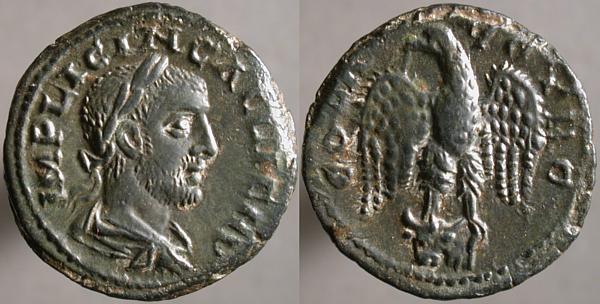
IMP LICIN GALLIENV, Laureate draped bust right | COL A_VG TRO, Eagle standing facing on bucranium, head left, wings spread.
I've previously posted a similar coin with the reverse legend broken differently, and with the eagle's head turned the other way, apparently Bellinger A458 (he specifies head right, but doesn't specify the legend breaks nor plate the coin.) This city also produced coins with an eagle flying while holding a bucranium.
Monday, October 11, 2004
Æ double sestertius, anonymous, time of Gallienus, Rome, Göbl 702h
Æ double sestertius, anonymous, time of Gallienus, Rome, Göbl 702h
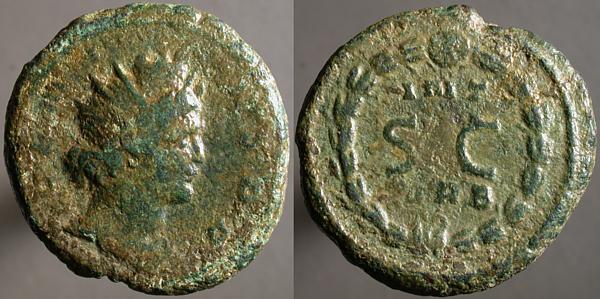
GE[NI]VS P R, Radiate head of Genius of the Roman People right, wearing rostral crown | INT / VRB above and below large S C, all within wreath.
The short version: over 1,700 years ago, these were produced in Rome. Almost 450 years ago, Sebastiano Erizzo mentioned them in a book published in Venice. Between, the Dark Ages. Since, vast improvements in our chronology of imperial Rome. Still, imperfect consensus on what these were, and on whose idea they were.
The most popular dates for these are, one the one hand, the end of Gallienus's reign and, on the other, an interregnum between the reigns of Aurelian and Tacitus.
Because it's big and bronze and features a radiate bust, and because there are smaller, lighter, coins of this series with laureate busts, it's most commonly thought to be a double sestertius, though some have said that it wasn't a coin at all.
In the 1979 edition of the Royal Numismatic Society's The Numismatic Chronicle, David Yonge's article "The So-Called Interregnum Coinage" compellingly argues that these date from Gallienus's last year, in anticipation of his triumpant return to Rome after defeating the Herulians and Goths at Naissus.
Gallienus, however, did not return to Rome as may have been planned. He instead turned aside to defeat the army of the usurper Aureolus and to besiege them at Milan. During that siege he was assassinated by his officers.

GE[NI]VS P R, Radiate head of Genius of the Roman People right, wearing rostral crown | INT / VRB above and below large S C, all within wreath.
The short version: over 1,700 years ago, these were produced in Rome. Almost 450 years ago, Sebastiano Erizzo mentioned them in a book published in Venice. Between, the Dark Ages. Since, vast improvements in our chronology of imperial Rome. Still, imperfect consensus on what these were, and on whose idea they were.
The most popular dates for these are, one the one hand, the end of Gallienus's reign and, on the other, an interregnum between the reigns of Aurelian and Tacitus.
Because it's big and bronze and features a radiate bust, and because there are smaller, lighter, coins of this series with laureate busts, it's most commonly thought to be a double sestertius, though some have said that it wasn't a coin at all.
In the 1979 edition of the Royal Numismatic Society's The Numismatic Chronicle, David Yonge's article "The So-Called Interregnum Coinage" compellingly argues that these date from Gallienus's last year, in anticipation of his triumpant return to Rome after defeating the Herulians and Goths at Naissus.
Gallienus, however, did not return to Rome as may have been planned. He instead turned aside to defeat the army of the usurper Aureolus and to besiege them at Milan. During that siege he was assassinated by his officers.
Sunday, October 10, 2004
Æ28, Aegeae in Cilicia, Valerian, Lindgren I, 1412 (this coin)
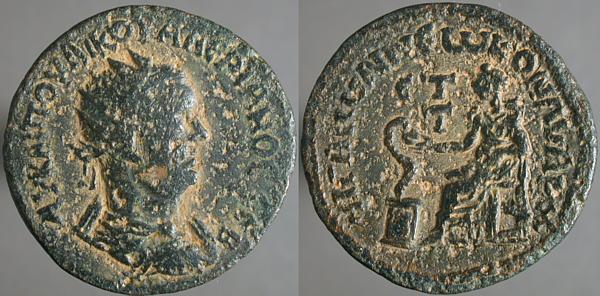
ΑΥ ΚΑΙ ΠΟV ΛΙΚ ΟVΑΛΕΡΙΑΝΟC CΕΒ, Radiate draped cuirassed bust right | ΑΙΓΑΙωΝ ΝΕωΚΟ ΝΑVΑΡΧ, Hygeia seated left, feeding serpent rising from basket left. ΕΤ / Τ in left field.
Hygeia is more often portrayed standing but here she's seen seated beside a cista mystica. Even more unusual for this era is the letter form used for omega: not the usual Ω, but a character that looks like a larger lower-case omega: ω. This can be most clearly seen just right of 12:00 on the reverse.

